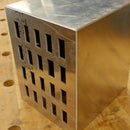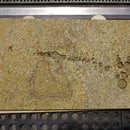Introduction: 3D Modeling San Francisco Cisterns
How do you create a 3D model of something that lives underground and only exists in a handful of pictures taken from the interior?
The backstory: all over the city of San Francisco are brick circles at various intersections. What the heck do they mean? I was determined to find out.
This Instructable is one of many short investigations, all part of a larger project, called Water Works, which is a data-visualization and mapping of the San Francisco water infrastructure: the pipes, hydrants and treatment plants that keep this city alive.
This work is from a Creative Code Fellowship, supported by Gray Area, Stamen Design and Autodesk.
Step 1: A Brief History Lesson
After your read about them, you will see these brick circles everywhere (in San Francisco). You can even find them on Street View.
It turns out that underneath each circle is an underground cistern.
There are 170 or so of them spread throughout the city. They’re part of the AWSS (Auxiliary Water Supply System) of San Francisco, a water system that exists entirely for emergency use and is separate from the potable drinking water supply and the sewer system.
In the 1850s, after a series of Great Fires in San Francisco tore through the city, 23 cisterns* were built. These smaller cisterns were all in the city proper, at that time between Telegraph Hill and Rincon Hill. They weren't connected to any other pipes and the fire department intended to use them in case the water mains were broken, as a backup water supply.
They languished for decades. Many people thought they should be removed, especially after incidents like the 1868 Cistern Gas Explosion.
However, after the 1906 Earthquake, fires once again decimated the city. Many water mains broke and the neglected cisterns helped save portions of the city.
Afterward, the city passed a $5,200,000 bond and begin building the AWSS in 1908. This included the construction of many new cisterns and the rehabilitation of other, neglected ones. Most of the new cisterns could hold 75,000 gallons of water. The largest one is underneath the Civic Center and has a capacity of 243,000 gallons.
The original ones, presumably rebuilt, hold much less, anywhere from 15,000 to 50,000 gallons.
* from the various reports I've read, this number varies.
Step 2: From a Reference Photo, Make a Sketch, Model in Fusion 360
I couldn't find very many photos of the inside of a cistern. This one was the best.
From this I drew a simple sketch, which replicated the imagined form: of a rounded cylinder with a manhole cover on top. The diameter appeared seems much greater than the height.
With the help of guru, Taylor Stein, I modeled this in Fusion 360 (we'll skip this step as you'll see why in just a minute).
Step 3: What's Wrong With This Picture?
Look closely. This looks like a hamburger with a nipple on top.
Not a cistern.
Back to the drawing board, or in this case, the 3D-modeling program.
Step 4: Find a New Reference Photo
With a large diameter and short height, a cylinder always resembles a hamburger. There's getting around it.
I spent a lot of time scouring the web for a new reference photo. I eventually found this one, which is a German cistern...from somewhere. It was perfect. The cap looks like it screws on like a giant concrete container. The three rectangles keep it from looking like a plastic tortilla warmer. It's not too tall or too short to look a port or anything else specific.
Step 5: Model in Fusion 360
Back to Fusion 360 and together, Taylor and I knocked this one out in less than 30 minutes.
Using a series of 2D drawings, we swept the basic shape into a 3D form. Then,we added the rectangles and repeated them at 120-degree angles.
Step 6: Done!
Rendered in a concrete and 3D-printed in white resin.
And I even have an online map (which will get better) of the cisterns.
Want to print your own? Here's the Thingiverse link.
I hope this was helpful, or at the very least informative
For more on the San Francisco Water Works project, you can find me here:





